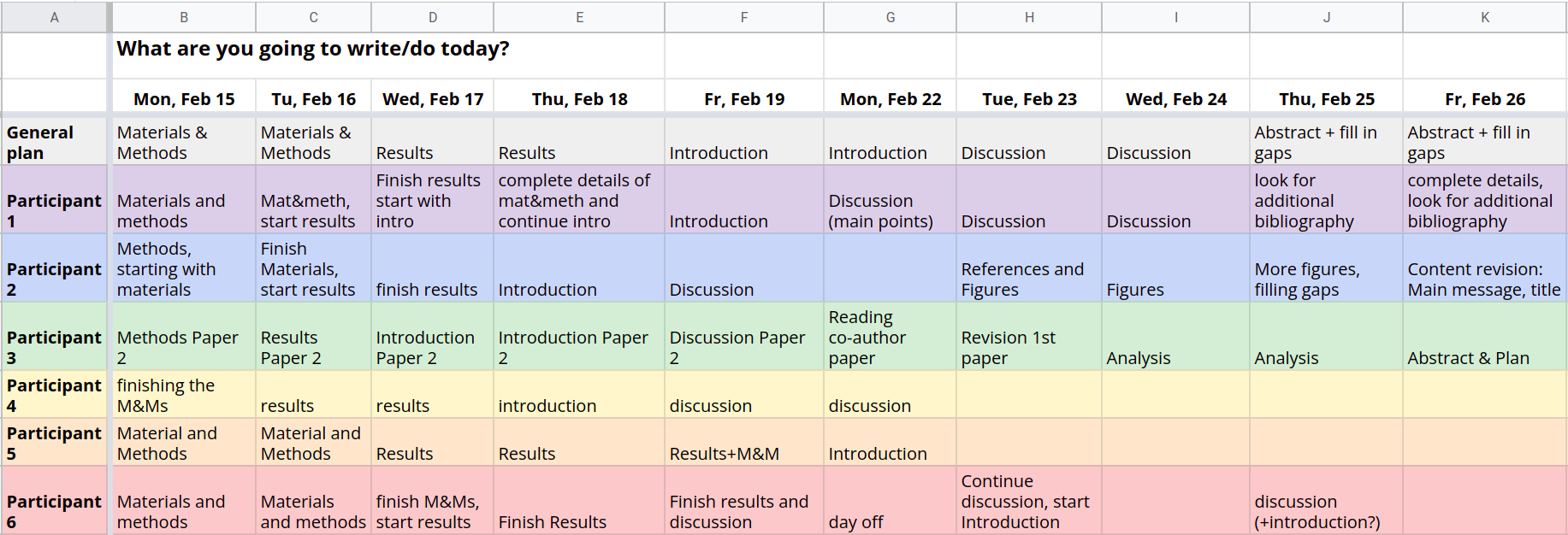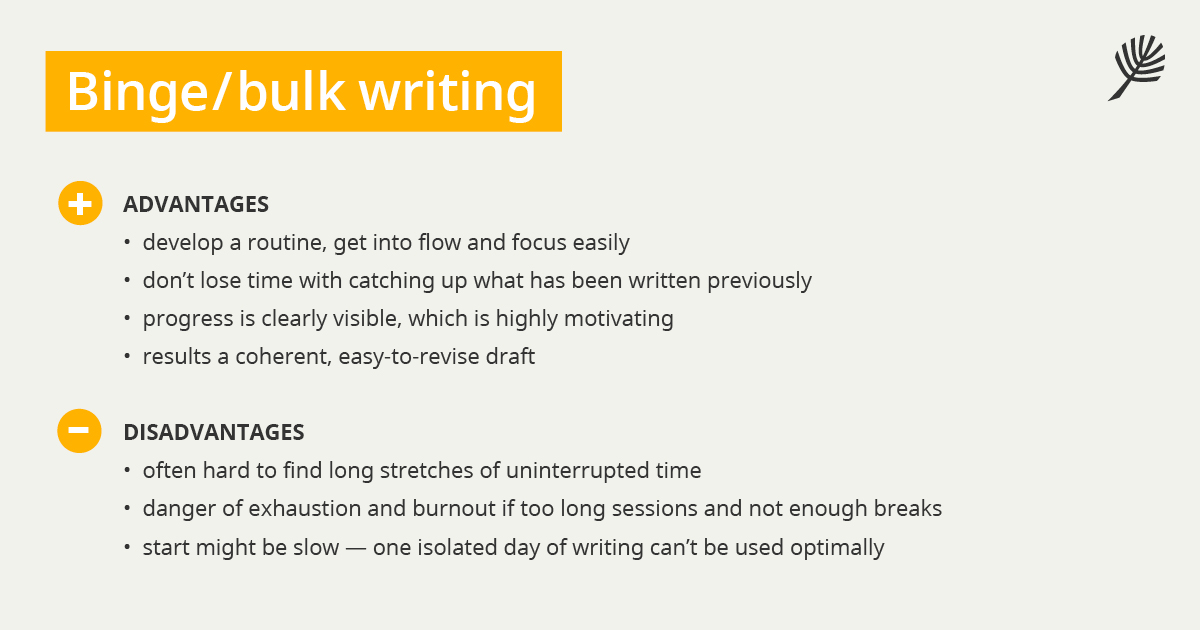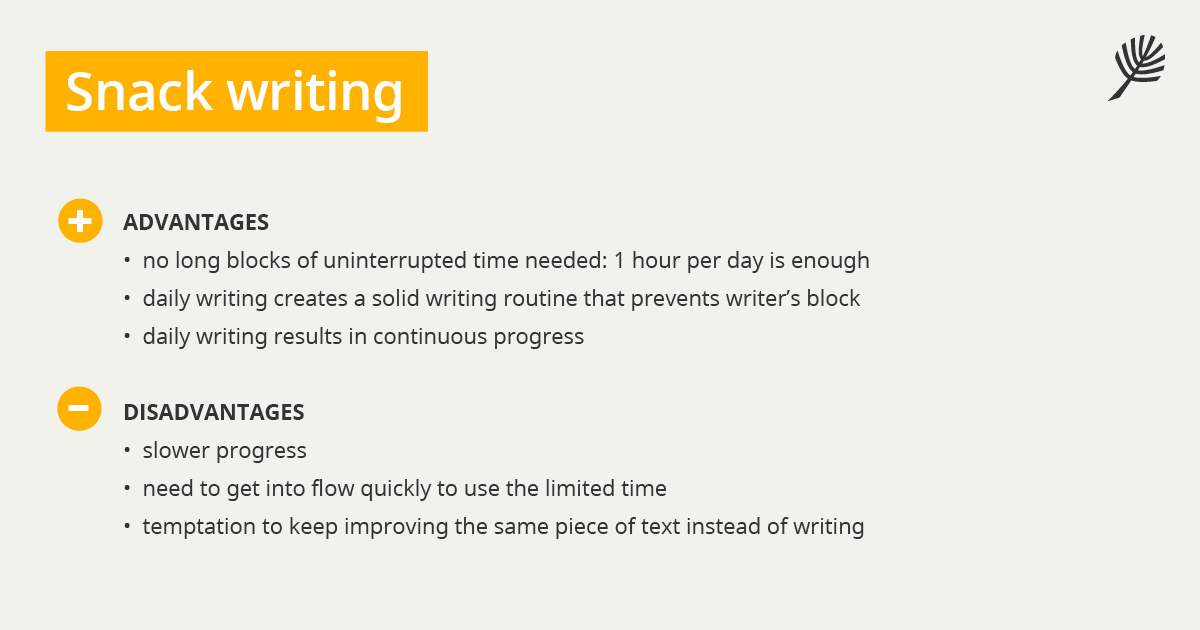
How do you write your scientific texts? Do you block off a whole day and barricade yourself at home or a library so you can properly focus? Or do you try to use shorter times like your daily commute or gaps in your schedule, maybe because that’s all you’ve got? Both strategies — binge writing and snack writing, as they are typically called — have their pros and cons. Read on and learn when to choose which approach and how to combine them for the best result.
There are different ways to organize your writing time:
Binge writing refers to the strategy of using large blocks of time — typically half a day or a full day — during which you do nothing but write. These sessions are repeated usually at irregular intervals, when the schedule allows again for a large chunk of writing time.
On the other side of the spectrum is the so-called snack writing strategy where you write in short bursts of 1-2 hours at a time, but do so regularly, possibly daily.
As you might expect, both strategies have their pros as well as cons. So let’s have a closer look at how we can use them optimally, each one on its own and together in a combination.
From binge writing to bulk writing
First off: Binge writing has a bad reputation. The psychologist Paul J. Silvia describes the issue in his book “How to write a lot” in the following way:
Most people use a wasteful, unproductive strategy called binge writing (Kellogg, 1994). After intending to write, procrastinating, and feeling guilty and anxious about procrastinating, binge writers finally devote a Saturday to nothing but writing. This creates some text and alleviates the guilt, and the binge-writing cycle begins anew.
Indeed, if you end up binge-writing as a result of your endless procrastination and the accumulating stress and guilt, then this is surely no healthy strategy. It fits very well to the meaning of the word “binge”, which denotes a time of excessive indulgence in an activity.
So let’s use another name for a writing strategy where you utilize larger chunks of time in a healthy, controlled manner: bulk writing.
Write up your paper in bulk
I like to write my research articles and book chapters in bulk and block off several days up to a week or two for writing.
In this way I can write up the first draft of an original research article in a week or two. Within the first few days I settle into a deep flow and routine, and then focus comes easily. I feel efficient because I can remember clearly what I did the previous day; I don’t lose time catching up. I feel motivated because the progress is clearly visible: new pages of text appear every day. And the draft I produce is coherent and therefore easy to revise.
As you can see, this “bulk writing” strategy is highly effective and deeply satisfying. It’s the basis of my online course Write Up Your Paper and other similar courses I am conducting for various research institutions. The many dozens of previous participants confirm: this way you can indeed write up a whole research article in a week or two.

Breaks are essential
But — and there is a crucial BUT: If you want to reap all the great benefits of bulk writing and write productively over several days or even weeks without exhaustion, you need to grant yourself regular breaks and sufficient time for rest.
First: don’t overdo it. In my experience, writing for six hours per day (excluding breaks) is usually the maximum for sustainable writing. Sure, you could do more than six hours on one day — but that would compromise your energy and focus for the next day.
We are not robots. Even with coffee or other stimulants, we need time to replenish our resources. Otherwise we risk exhaustion and burnout.
Next: besides a reasonable daily pensum, you also need breaks during the day. Longer breaks of 30-60 min after every 1.5-2.5 hours of work and ideally also shorter breaks of 5-10 minutes after every 25-50 minutes of work. Both types of breaks are part of the Pomodoro method. They help your body get refreshed, so you can stay focused and productive over the whole day.
You need more than one day
Now, the most common issue with the bulk writing strategy is the lack of uninterrupted time. One day now and then is not really helpful: you need at least two days to benefit from the deep focus as it doesn’t come immediately if you don’t write regularly.
From bulk writing to snack writing
If you can’t block off whole days for writing, a great compromise is half days. For example, you could write in the morning for 2-3 hours every day for a week. Or on 3-4 days a week over a couple of weeks or even months. This leaves the afternoons free for other tasks, so it often works as a long-term strategy, for example, when you need to write up your thesis but still have other things to do as well.
The general rule is: the shorter your writing session, the more important is the regularity. Which brings us to the snack writing strategy located on the other side of the spectrum…
Take your writing in regular snacks
I often work with researchers who are so busy with their research, teaching, administration and mentoring, that they have hardly any time left for writing.
If you can’t reserve 2-3 hour blocks of time for writing, then you simply need to work with what you have: your daily train commute, or that quiet moment after lunch, or maybe you can get up half an hour earlier to write.
Now you might be thinking: well, that’s nice in theory, but I need a while to get into the writing. When I only have one hour of time, I don’t even bother to start.
In my experience, it’s absolutely possible to effectively use short periods of 30-60 minutes for writing — but you need to do so regularly, ideally daily. This creates a routine, your brain gets used to utilizing these short sessions.
What helps even more is to keep the writing session at the same time, whether in the absolute terms (e.g., 9-10 AM) or as a relative position in your schedule (e.g. “after arriving in the office, I’ll write for one hour”).
Create a starting ritual
A powerful trick to get yourself into a writing mode quickly is a starting ritual: some short activity that you do before every writing session, like a little stretch or brewing a cup of tea. With time, your brain will associate this little ritual with writing and as you stretch or prepare your cup of tea, you will feel getting calmer and focused — and ready for writing.
The ultimate starting ritual is 5-10 minutes of freewriting where you write down anything swirling through your head (so it won’t distract you later when you write) and if there is some time left, then write about what is going to happen during the upcoming session: What are you going to write about? How are you going to start? What are the open questions, do you have any doubts? If you feel unmotivated: how can you motivate yourself?
Such a quick freewriting exercise gets you ready for writing: it warms up your writing faculties, clears your mind and gets you focused, and makes the writing task concrete and tangible in your mind.
Snack yourself through the text paragraph by paragraph
If you want to optimally use short time windows, it’s essential to think in paragraphs. Paragraph is the basic unit of a text, covering one idea, topic or point.
So if you have only 30-60 minutes of time for writing, you can opt for writing one or two paragraphs. You can use the freewriting warm-up to figure out which paragraph(s) you want to write today and what are the relevant pieces of information you want to include.
This allows you to find a natural closure at the end of every writing session, even if it’s only a short one. And paragraph by paragraph, you’ll snack yourself through the whole text.
Slow but steady progress
Of course the progress is much slower when writing in snacks than when writing in bulk. But if you keep writing (almost) daily, the progress will be steady and ultimately lead to the completion.
If you write (almost) daily, you’ll develop a solid writing routine, which is the best prevention of writer’s block. And you’ll feel great about using your limited time effectively and making progress on your important writing.
Don’t get stuck in endless revisions
A major danger of short writing sessions is the easiness of wasting it. Starting rituals and especially freewriting help you get started quickly. But then you need to focus on writing new text and resist the temptation to improve what you have written before.
This temptation is particularly strong if you read the previously written text as a way to remember where you are and how you want to continue. To not fall in the revision trap, you could remind yourself during the freewriting that you will only quickly look through the text without starting to fix it.
Alternatively, you can write down at the end of each session a few notes about what has to come next. So when you start the next session, you don’t need to read the previous paragraph — you have the notes to work with.
Regularity is the key for both strategies
Both the bulk writing and snack writing strategies have distinct benefits and challenges. But they have one thing in common: the best results are achieved over repeated sessions. Bulk writing periods are typically shorter, lasting a couple of days up to a couple of weeks. On the other hand, snack writing is a great long-term strategy for months and even years.
In both cases writing every work day is optimal. But if it’s not possible for whatever reason, you do what you can and use the time you have available, of course. Be careful to not take suboptimal writing conditions as an excuse for not writing at all!
When to choose which strategy?
Bulk writing is great for relatively short writing projects that you can plan out in advance, like an original research article. Provided, of course, that you can block enough time in your daily schedule: half-days or full days on most of the work days.

If you can’t block enough time for bulk writing, then snack writing is your option. Snack writing is also great for longer writing projects like a doctoral thesis, or thinking-heavy projects like grant proposals that you develop step-by-step during the writing process.

Combine for the best result
It can be very productive to combine both ways of writing:
Kickstart a bigger writing project with bulk writing, especially when you feel unmotivated and procrastinate instead of starting to write. After a week or two of intense writing you can switch to a lower tempo (maybe 1-2 hours per day), benefiting from the motivation and momentum generated during the bulk-writing period. And if you later realize that the deadline is approaching, you can again increase the tempo and finish the project in a bulk-writing week or two.
But, at the end, it’s all up to you and what works specifically for YOU and your current situation. It’s good to know your options and try out different approaches, so you can pick the right strategy for your present situation.
So: Do you have a writing approach that works for you well? What does it look like? Please, share it with us in the comments, for inspiration 🙂